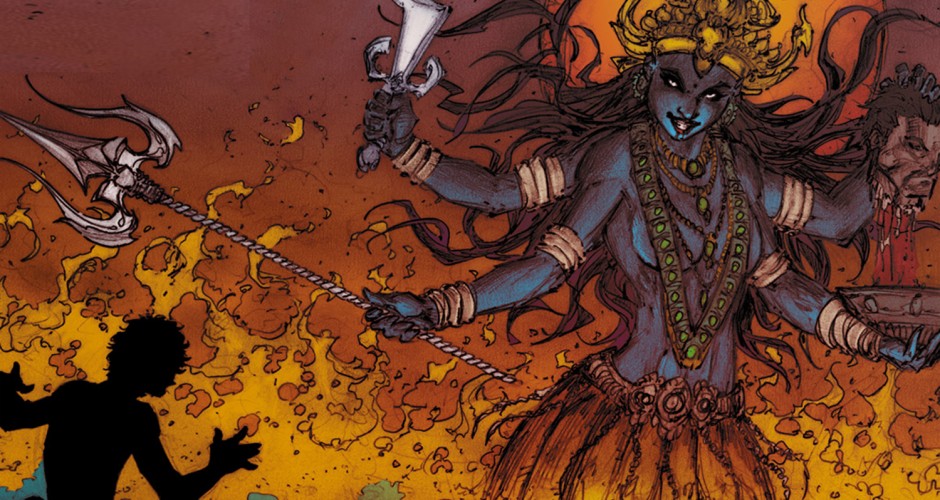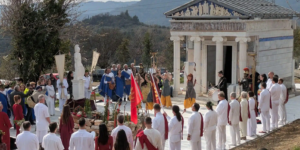Kali is one of the best known, but poorly understood forms of the Goddess. She is dark destructive and terrible in image. She is allied to the forces of death and destruction. The most common image of Kali shows her dancing on Shiva. This article aims to give an insight into Hinduism\’s use of such mystic imagery.
Shiva & Shakti
 Within Hinduism, the divine is not restricted solely as masculine or feminine, which is a unique feature compared with other major religions of today. The divine is not referred to only as \’He\’. In the Shaivite tradition, the supreme divine reality is represented as Shiva-Shakti. Shiva is the masculine force, the power of peace, while Shakti translates to power, and is considered as the feminine force. In the Vaishnava tradition, these realities are portrayed as Vishnu and Laxmi, or Radha and Krishna. These are differences in formulation rather than a fundamental difference in the principles.
Within Hinduism, the divine is not restricted solely as masculine or feminine, which is a unique feature compared with other major religions of today. The divine is not referred to only as \’He\’. In the Shaivite tradition, the supreme divine reality is represented as Shiva-Shakti. Shiva is the masculine force, the power of peace, while Shakti translates to power, and is considered as the feminine force. In the Vaishnava tradition, these realities are portrayed as Vishnu and Laxmi, or Radha and Krishna. These are differences in formulation rather than a fundamental difference in the principles.
Both Shiva and Shakti have various forms. Shiva has forms like Yogi Raj (the common image of Himself meditating in the Himalayas), Rudra (a wrathful form) and Nataraj (performing the dance of destruction).
About Kali
 The Sanskrit word Kali literally means \”time\”. Kali is the feminine word for time, for which the masculine is \”kala\”. Time as we are forced to understand it, is the foremost power that we experience. Kali is the personification of time and it is not surprising that the deity of time has a terrifying image. After all, time is the slayer of all. Time is the very stuff that our lives are made of – to waste time is to waste life. The reason as to why time is represented in a feminine form is that time is the great womb – the great mother – from which we are all created – therefore it has a feminine quality. Time is also the force which causes all living beings to perish. Therefore Kali is like the mother who destroys the children which she has created – which is one of her frightful features. Yet, through the action of time, Her action, occurs our salvation. Through time, over repeated births, we experience all that we have to and learn all that we must learn in order to merge back into our eternal existence, from which we fell into limited time and space.
The Sanskrit word Kali literally means \”time\”. Kali is the feminine word for time, for which the masculine is \”kala\”. Time as we are forced to understand it, is the foremost power that we experience. Kali is the personification of time and it is not surprising that the deity of time has a terrifying image. After all, time is the slayer of all. Time is the very stuff that our lives are made of – to waste time is to waste life. The reason as to why time is represented in a feminine form is that time is the great womb – the great mother – from which we are all created – therefore it has a feminine quality. Time is also the force which causes all living beings to perish. Therefore Kali is like the mother who destroys the children which she has created – which is one of her frightful features. Yet, through the action of time, Her action, occurs our salvation. Through time, over repeated births, we experience all that we have to and learn all that we must learn in order to merge back into our eternal existence, from which we fell into limited time and space.
Why Is She Dancing On Shiva?
 Shiva, in the Shaivite tradition, is the all pervading eternal primeval consciousness of the universe and beyond, who is beyond motivation. Hence, He is commonly shown as meditating in tranquil. His action and motivation occur only prior to the final destruction and dissolution of this cycle of creation. Hence, when Shiva dances, it is considered to be the terrible awesome dance of destruction.
Shiva, in the Shaivite tradition, is the all pervading eternal primeval consciousness of the universe and beyond, who is beyond motivation. Hence, He is commonly shown as meditating in tranquil. His action and motivation occur only prior to the final destruction and dissolution of this cycle of creation. Hence, when Shiva dances, it is considered to be the terrible awesome dance of destruction.
It is on the passive, ultimate reality of Shiva, that Kali (time) does her dance, causing the constant cycles of creation, life and death of all things in the universe. Shiva is the substratum upon which Kali acts. Hence, in this part of the Hindu spiritual traditions, the entire divine action and existence is represented by the dance of Kali (time) upon the changeless all pervading consciousness, Shiva.
 Does Kali actually have a separate consciousness or is she just a representation of time as an unthinking scientific principle?
Does Kali actually have a separate consciousness or is she just a representation of time as an unthinking scientific principle?
Hinduism personifies what to us are abstract spiritual truths as Gods and Goddesses. Spiritual ideas are clothed in concrete imagery, and approached as living beings. This does not reflect a lack of reasoned thinking, or attachment to form, but rather an experiential contact with the higher truths, as living forces. Hinduism creates a personal relationship between ourselves and the forces of the cosmos, and eventually leads us to realise that these forces are within us rather than separate. All forces of the universe are pervaded by consciousness, hence the reason as to why they are approached as living beings is because in reality, they are. The purpose of vivid imagery is that whilst meditating upon the image, our mind is shocked into thinking into the depths of the concept we are trying to understand and know, beyond our usual conditioned ideas. In that way we can really experience the truth of  time as an awesome conscious force and understand how our existence relates to it. Kali is a particularly important deity, because by understanding Her we stop identifying ourselves as only our body – we come to terms with the utter impermanence of our body and begin to perceive the true existence of ours which lies beyond – which most people believe but wish to experience directly. Hence she is said to kill the ego – the attachment to pettiness, which is represented in Her image by the severed head she hold in Her hand.
time as an awesome conscious force and understand how our existence relates to it. Kali is a particularly important deity, because by understanding Her we stop identifying ourselves as only our body – we come to terms with the utter impermanence of our body and begin to perceive the true existence of ours which lies beyond – which most people believe but wish to experience directly. Hence she is said to kill the ego – the attachment to pettiness, which is represented in Her image by the severed head she hold in Her hand.
A Mantra For Kali
One important Mantra for Kali is:
om aim hrim klim camundayai vicche svaha!
Each syllable of this mantra conveys a distinct vibrational energy, and whoever chants this mantra, after a short while will feel that they are tapping in to a deep spiritual energy.

Om is the sound corresponding to the absolute reality in its entirety. Aim is the syllable of knowledge (Sarasvati). Hrim is the syllable of purification (Parvathy). Klim is a syllable corresponding to transformation (closely related to Kali). Camundayai is a name of Kali. Vicche means cut (as in to cut of the head of the demon, demon referring to the ego) and svaha ends the mantra.































